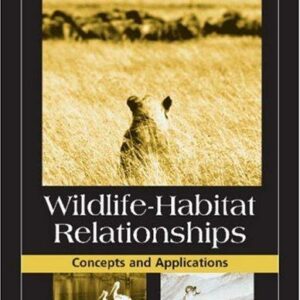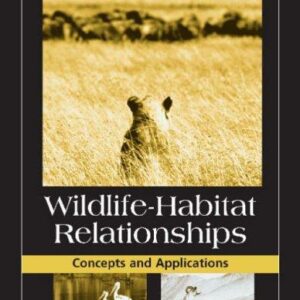Ecology on Campus
$133.32
| Title | Range | Discount |
|---|---|---|
| Trade Discount | 5 + | 25% |
- Description
- Additional information
Description
This flexible laboratory manual contains nearly 60 exercises involving small-scale ecological systems that can be conducted within a weekly lab period right on campus, regardless of weather or resources available. Each chapter explains a fundamental concept, and then gives three separate hands-on exercises that can involve outdoor observation and measurements on campus, laboratory systems, library research, biological collections, or computer resources.
Additionally, calculation pages accompanying each lab walk students through standard mathematical modeling or statistical tools commonly used by ecologists to address the question at hand, building students’ quantitative and critical thinking skills. All calculations and statistical analyses can be completed by students using simple calculators.
This flexible laboratory manual contains nearly 60 exercises involving small-scale ecological systems that can be conducted within a weekly lab period right on campus, regardless of weather or resources available. Each chapter explains a fundamental concept, and then gives three separate hands-on exercises that can involve outdoor observation and measurements on campus, laboratory systems, library research, biological collections, or computer resources.
Additionally, calculation pages accompanying each lab walk students through standard mathematical modeling or statistical tools commonly used by ecologists to address the question at hand, building students’ quantitative and critical thinking skills. All calculations and statistical analyses can be completed by students using simple calculators.
PREFACE: TEACHING AND LEARNING ECOLOGY IN A CAMPUS ENVIRONMENT
1. DESCRIBING A POPULATION
Exercise A: Seed weights in legumes
Exercise B: Needle length in conifers
2. ALLOMETRIC RELATIONSHIPS
Exercise A: Modeling size and shape relations
Exercise B: Heat exchange in beetles
Exercise C: Size and shape of trees
3. ESTIMATING POPULATION SIZE
Exercise A: Mark-recapture simulation
Exercise B: Mark-recapture estimate of a student population
Exercise C: Mark-recapture estimate of a mealworm population
4. POPULATION GROWTH
Exercise A: Calculating r from a published data set
Exercise B: Comparing exponential and logistic growth
Exercise C: Population growth of yeasts
5. DEMOGRAPHY
Exercise A: Demography simulation
Exercise B: Developing a life table from the alumni newsletter
Exercise C: Demography of campus trees
6. POPULATION GENETICS
Exercise A: Population genetics simulation
Exercise B: Hardy Weinberg equilibrium in a fruit fly culture
7. SPATIAL DISTRIBUTION OF POPULATIONS
Exercise A: Dispersion of plants in a lawn community
Exercise B: Dispersion of herbivores on plant resource units
Exercise C: Dispersion of isopods in an artificial habitat
8. THE NICHE
Exercise A: Feeding niches in the community aquarium
Exercise B: Niches of birds at a feeding station
Exercise C: Plant niches on a disturbance gradient
9. THE CONCEPT OF THE COMMUNITY
Exercise A: Geographical distributions of tree species
Exercise B: Direction of exposure and plant communities
Exercise C: Microbial communities on a salt concentration gradient
10. COMPETITION
Exercise A: Demonstrating allelopathy
Exercise B: Competition within and between species
Exercise C: Competition problems
11. PREDATION AND PARASITISM
Exercise A: Predator/prey simulation
Exercise B: Predation by Daphnia on Euglena
Exercise C: Simulating functional responses of a predator
12. MUTUALISM
Exercise A: Effects of Rhizobium on legumes
Exercise B: Microbial symbionts in termite gut and lichen thallus
Exercise C: Flower/pollinator mutualism
13. BIODIVERSITY
Exercise A: Measuring biodiversity of campus birds
Exercise B: Measuring invertebrate biodiversity
Exercise C: Measuring biodiversity in sweep net samples
14. ECOLOGICAL SUCCESSION
Exercise A: Succession in hay infusions
Exercise B: Comparing r-selection and K-selection in trees
15. PHYSICAL AND CHEMICAL ATTRIBUTES OF SOILS
Exercise A: Physical properties of soils
Exercise B: Soil pH in two microhabitats
Exercise C: Nutrient capture by soils
16. AQUATIC SYSTEMS
Exercise A: Dissolved oxygen and temperature
Exercise B: Sediment load and water clarity
Exercise C: LD50 determination for a pesticide
17. ENERGY FLOW
Exercise A: Productivity of plankton
Exercise B: Pyramid of biomass for plankton
Exercise C: Estimating ecological efficiency of leaf miners
18. ISLAND BIOGEOGRAPHY
Exercise A: Biogeography simulation game
Exercise B: Species-area relationship for bird communities
APPENDIX 1: The variance
APPENDIX 2: Critical values for the t-test
APPENDIX 3: Correlation and regression
APPENDIX 4: Critical values for the Mann-Whitney U test
APPENDIX 5: Critical values for the Chi-square test
APPENDIX 6: A table of random numbers
APPENDIX 7: Writing a laboratory report
Comprehensive glossary of ecological terms
Additional information
| Dimensions | 1.00 × 9.10 × 10.90 in |
|---|---|
| Imprint | |
| Format | |
| ISBN-13 | |
| ISBN-10 | |
| Author | |
| BISAC | |
| Subjects | science, biology, life sciences, ecology, SCI026000, higher education |







